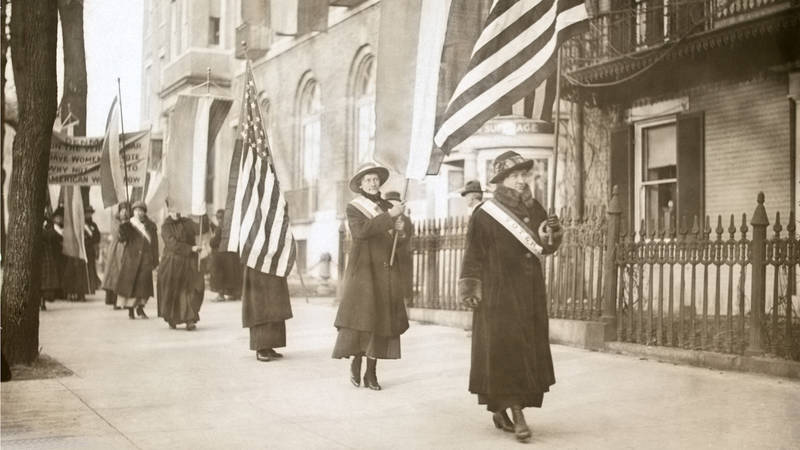150 years ago this month, General Robert E. Lee surrendered to General Ulysses S. Grant at Appomattox Court House in Virginia, leading to the end of the Civil War. The conflict cost more than 600,000 American lives and nearly split our nation in two.
Today, Civil War battlefields offer visitors the opportunity not only to learn about American military history, but also to understand more deeply the war’s causes, its consequences, and its relevance to our lives today. In addition, battlefields provide critical habitat for native plants and animals, from bald eagles at Shiloh to pink lady slippers at Petersburg.
As the nation looks back over those four bloody years, here are some of the battlefields advocates have been able to protect so that we can continue preserving this history for future generations.
1. Harpers Ferry National Historical Park, West Virginia, Virginia, and Maryland
The story: John Brown tried to ignite an uprising among local enslaved people with his 1859 raid on the federal armory in the town of Harpers Ferry. Instead, federal troops under Colonel Robert E. Lee defeated his followers and the state of Virginia sentenced him to death. Still, the insurrection added fuel to the fire that led to the Civil War. Violence returned to Harpers Ferry in 1862, when Confederate troops won a battle there on their way to Antietam.
What you helped to save: In 2002, NPCA and its advocates led a campaign to protect the historic Murphy Farm from a proposed 200-unit housing development, achieving permanent protection for the site as part of the park. NPCA and our allies then successfully advocated for legislation signed by President George W. Bush in 2004 to add more than 1,200 acres to the national park, and secured the necessary federal grants. In 2013, NPCA helped purchase four acres of undeveloped land in the heart of the battlefield to add to the park.
2. Monocacy National Battlefield, Maryland
The story: Confederate troops attempted a daring raid on Washington, D.C., from the north late in the war, hoping to divert Union troops from their siege of Petersburg. A small Union force sent to Monocacy from Baltimore was able to slow the Confederates long enough for reinforcements to arrive at the capital, in what became known as “the Battle that Saved Washington.”
What you helped to save: Frederick and Carroll Counties had planned to build a trash-burning incinerator along the Monocacy River, a stone’s throw from the battlefield. The plant’s smokestack would have towered over the park, impacting the air quality and visitor experience. NPCA worked for years and advocates spoke out numerous times to oppose the incinerator, which the counties finally abandoned in December 2014.
3. Gettysburg National Military Park, Pennsylvania
The story: Perhaps the most famous battle of the Civil War, Union and Confederate troops met in an epic clash in south central Pennsylvania in July 1863. With massive casualties on both sides, the battle was considered a Union victory and a major turning point in the war.
What you helped to save: NPCA and its advocates have been involved in many Gettysburg issues over the years. In late 2014, Congress passed an NPCA-supported bill that added the historic train station (shown here) in downtown Gettysburg–where President Lincoln arrived to give the Gettysburg Address–to the national park. NPCA also won several fights over the years to prevent or remove incompatible development from Gettysburg, including stopping not one but two casinos proposed within cannon range of the national park, and removing outdated structures on top of Cemetery Ridge and a supersized observation tower that harmed the park’s historic appearance. Thousands of advocates around the country helped push for years to achieve these victories.
4. Fort Monroe National Monument, Virginia
The story: Finished in the 1830s, the fort at the end of the Old Point Comfort peninsula played an important role during the Civil War. Remarkably, Union troops controlled the fort at the mouth of the Chesapeake throughout the war. It became known as “Freedom’s Fortress” after Major General Benjamin Butler provided refuge to enslaved people who managed to make their way to the fort.
What you helped to save: NPCA worked for years as part of a dedicated coalition to preserve Fort Monroe as part of the National Park System. The effort culminated in November 2011, when President Obama used his powers under the Antiquities Act for the very first time to designate part of Fort Monroe as a national monument, with most of the peninsula’s historic structures managed by the state-led Fort Monroe Authority. This enormous victory involved a sustained long-term advocacy effort as well as a passionate group of local citizens working on the ground to make this happen.
5. Harriet Tubman Underground Railroad National Monument, Maryland, and Harriet Tubman National Historical Park, New York
The story: Harriet Tubman, one of the most famous women in American history, managed to free nearly 70 enslaved people from plantations on Maryland’s Eastern Shore in dangerous missions to safety along the Underground Railroad. Tubman’s spirit was an inspiration for countless others struggling for equality and civil rights.
What you helped to save: NPCA and its advocates played a key role in urging President Obama to use the Antiquities Act in 2013 to designate the Harriet Tubman Underground Railroad National Monument on Maryland’s Eastern Shore. NPCA continued working to protect lands associated with Tubman, helping to pass legislation in late 2014 creating the Harriet Tubman National Historical Park to protect her home in Auburn, New York, and to formally establish the Underground Railroad Monument in Maryland.
6. Vicksburg National Military Park, Mississippi
The story: The Siege of Vicksburg in 1863 was the final major action in the western theater of the Civil War, which gave the Union Army control of the entire Mississippi River. The siege ended a day after the Battle of Gettysburg in early July 1863, signaling a shift in momentum that eventually led to a Union victory.
What you helped to save: NPCA was able to secure the inclusion of 10,000 acres of core battlefield land around Vicksburg in the 2014 National Defense Authorization Act. As the Union Army troops worked their way around Vicksburg to set the siege they fought a series of battles, including engagements at Port Gibson, Champion Hill, and Raymond. Battlefield lands at these areas will be now included in the park, helping to tell the whole story of the siege.
7. Stones River National Battlefield, Tennessee
The story: Though it’s often overlooked, no major battle of the Civil War had a higher casualty rate than the Battle of Stones River. Fought in and around Murfreesboro through New Year’s Day 1863, the battle resulted in a Union victory that helped restore hope for the North in the wake of devastating defeats at Fredericksburg and Spotsylvania.
What you helped to save: In 2000, the state of Tennessee attempted to build a major interstate highway access through core battlefield land at Stones River National Battlefield. NPCA, coalition partners, and their numerous advocates worked hard against the plan, resulting in the highway being relocated.
8. Mill Springs Battlefield, Kentucky
The story: The Battle of Mill Springs in January 1862 was one of the first Union victories in the Civil War. Armies clashed in the cold woods of south-central Kentucky, resulting in nearly one thousand casualties.
What you helped to save: NPCA and its advocates were able to help pass legislation in late 2014 to initiate a special resource study to determine whether Mill Springs Battlefield would be appropriate to include in the National Parks System.
9. Fredericksburg and Spotsylvania National Military Park, Virginia
The story: The area in and around Fredericksburg, Virginia, saw four major Civil War battles: Fredericksburg, Chancellorsville, Wilderness, and Spotsylvania. In all, more than 85,000 men were wounded in these battles, and 15,000 killed. Visiting the park is a true immersive experience, with a wide variety of landscapes and structures to explore.
What you helped to save: In 2008, Wal-Mart planned to build a large store on a privately owned portion of the Wilderness battlefield adjacent to the national park. The privately owned land had served as hospital grounds during the battle. The enormous development would have made it nearly impossible to envision this important turning point in American history, and would have damaged the battlefield’s historic character. NPCA helped form the Wilderness Battlefield Coalition, which eventually convinced Wal-Mart to move the store three miles down the road, preserving hallowed ground.
Thousands of visitors will gather at Appomattox Court House National Historical Park this month to commemorate Lee’s surrender to Grant 150 years ago at the end of the Civil War. You can be part of these historic remembrances by planning a visit or taking part in a ceremonial bell-ringing on April 9. Learn more on the Park Service website. Plus, NPCA’s work to protect Civil War national parks won’t stop after the 150th anniversary is in the rearview mirror. Learn more about our work to save critical battlefield land from the Siege of Petersburg and to protect Manassas National Battlefield from a new highway proposal.
Stay On Top of News
Want more great national park stories and news? Join our email list and get them delivered to your inbox.
About the author
-
 Nicholas Lund Former Senior Manager, Landscape Conservation Program
Nicholas Lund Former Senior Manager, Landscape Conservation ProgramNick is a conservationist and nature writer. He is the author of several forthcoming books, including the American Birding Association Field Guide to the Birds of Maine (2022) and “The Ultimate Biography of Earth” (2022). His writing on birds and nature has appeared in Audubon magazine, Slate.com, The Washington Post, The Maine Sportsman, The Portland Phoenix and Down East magazine, among others.
-
General
-
- Parks:
- Fort Monroe National Monument
- Fredericksburg & Spotsylvania National Military Park
- Gettysburg National Military Park
- Harpers Ferry National Historical Park
- Harriet Tubman Underground Railroad National Historical Park
- Monocacy National Battlefield
- Stones River National Battlefield
- Vicksburg National Military Park
-
- NPCA Regions:
- Mid-Atlantic
- Southeast
-
-
Issues

